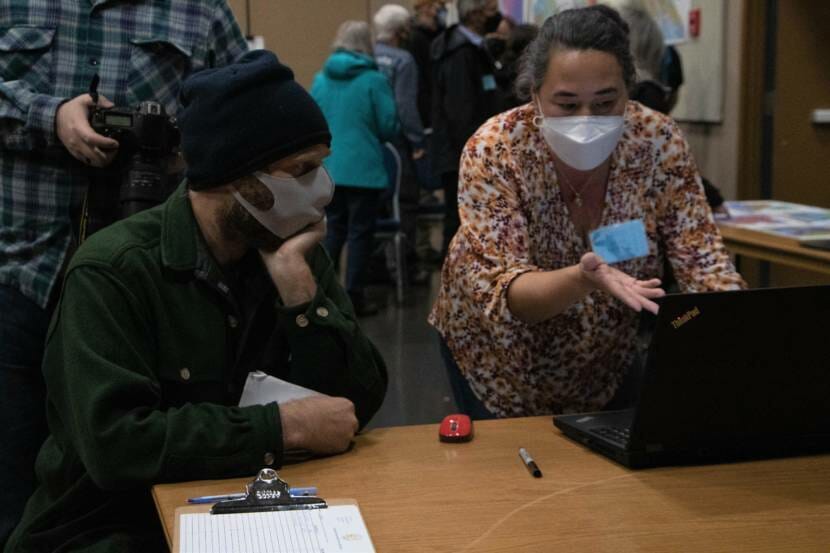
Members of the state board in charge of redrawing Alaska’s legislative districts got an earful from Juneau residents Monday. It was the first in a series of public hearings around the state.
The appearance of partisan gerrymandering at the expense of local incumbent Democrats preoccupied much of the event.
The event was intended to be an open house, with lots of options for people to send the Alaska Redistricting Board comments without getting in front of a microphone for all to hear. But the board pivoted to the one-at-a-time format after asking the crowd for a show of hands on its preference.
Three board members attended the event at Juneau’s convention center, including the authors of two proposals. They all maintained that the proposed maps were made without political considerations. Four other proposals by third-party organizations were also on display.
The skepticism in the crowd was palpable — and audible.
“You said you’re not thinking about where people live, incumbency, things like that,” Juneau resident Pat Race said to board Chairman John Binkley. “So maybe you could explain the tentacle that then incorporates Andi Story’s house into Sara Hannan’s district?”
Story and Hannan are Juneau’s Democratic incumbents in the Alaska House of Representatives. One board-authored map lumps some homes around Auke Bay and Auke Lake into a district anchored by downtown Juneau and Douglas Island, where Hannan lives. What Race called a “tentacle” is a feature that awkwardly pokes out along Glacier Highway for about one mile past the Auke Bay roundabout. That tentacle is on the waterfront side of the highway — with the exception of two peculiar nubs. Rep. Andi Story’s home is in one of those nubs.
As others in the crowd shouted affirmatively, Binkley responded: “Yeah, it’s — that’s a valid point. And I only know about that because I’ve read the press reports about that. It really is not anything that we look at —.”
This statement prompted harrumphs and an “Oh, god,” from the crowd.
“There are a lot of different appendages that go in different directions. It’s based on census blocks,” Binkley continued. “So sometimes there are, uh, odd shapes. We try to smooth those as much as we can and that’s what we continue to try to do.”
Race followed up with Juli Lucky, a staffer for the redistricting board. On a laptop, Lucky opened the software the board uses to make maps. Census blocks really are super irregular.

“We can show you, we got public testimony that one of the block lines goes right through someone’s house,” Lucky said. “So they’re like, ‘I don’t even know what district that I’m in.’ But we don’t know that until someone tells us.”
Board Deputy Director TJ Presley said it’s legal to split census blocks for redistricting purposes, but the courts discourage it. It would create a lot of practical problems with their software and data sets and for local governments that use the census and legislative district lines.
Board member Budd Simpson, who was appointed by Republican Gov. Mike Dunleavy, drew the map that was being scrutinized. He said he didn’t know specifically where Story lived until someone showed him at the event. He maintained he wasn’t gerrymandering.
Simpson said he read comments about the tentacle before this hearing and took another look at his map.
“To my eye, it didn’t look right,” Simpson said. “So I went back to the drawing board just today and tried another run at it, and I think may have solved the problem.”
Simpson said the guff the board got was understandable.
“And hopefully, we can move on from that,” he said.
The redistricting board members were appointed by different state officials. Three were picked by Republicans. One was picked by then-Alaska Supreme Court Chief Justice Joel Bolger, who’s politically undeclared. Nicole Borromeo was picked by a Democrat turned independent. She said that isn’t influencing her.
“Not at all, no,” she said. “I had a very candid conversation with the former speaker (Bryce Edgmon) when I accepted the position that I’m not looking to stack or crack any districts for a Republican, Democrat or independent. That I want to follow the constitution, federal and state law, both constitutions, and that’s going to be my guidepost throughout the process.”
“Stacking and cracking” or “packing and cracking” are specific ways to gerrymander that can distort political representation.
As far as her Republican-appointed colleagues, Borromeo said it’s early still. But so far, she said the board is working well together. On the tentacle, she’s satisfied with Simpson’s explanation that it was an accident. She doesn’t think he had partisan intent.
Borromeo drew the board’s other in-house map. It doesn’t appear to have any suspicious tentacles in Juneau. But it also lumps Juneau’s current House members into the same district. Her map carves a sort of donut hole district into Juneau made up of the Mendenhall Valley and Lemon Creek. The actual donut is the rest of Juneau — which includes both Hannan and Story’s homes — plus Hoonah, Gustavus, Skagway, Haines and Klukwan.
Gerrymandering concerns aside, one of Borromeo’s takeaways from the public hearing was that residents seem to want a clean split between downtown Juneau and the Mendenhall Valley.
Since Juneau’s population isn’t big enough to make up two full House districts on its own, Borromeo said she’s also looking for comments about which neighboring communities fit with Juneau’s districts.
In the big picture, it’s really difficult to analyze and summarize how each of the board’s maps and the other third-party plans could affect Alaska’s overall partisan representation. The blog The Alaska Landmine took a crack at it with the board’s maps. In both, the blog found varied partisan effects on House incumbents. Budd Simpson’s map does appear to disproportionately hurt incumbent House Democrats, but not exclusively. Nicole Borromeo’s map appears to pack an equal number of incumbent House Democrats and Republicans together.
The blog also went a step further to show the partisan leanings of the new, vacant House districts. That analysis suggests that it’s likely Democrats could have a net gain in House seats under Simpson’s proposed map.
The blog says a similar analysis of Senate districts is pending.
The redistricting board has until Nov. 10 to settle on a final plan.
The maps and a form for submitting comments are also available on the Alaska Redistricting Board website, www.akredistrict.org. Comments can also be emailed to testimony@akredistrict.org.
Since at least 1970, every time Alaska’s legislative district lines have been redrawn, lawsuits have followed and the courts have played a role in the final lines.
Disclosure: KTOO has occasionally hired Pat Race to produce art for KTOO products.





